Reading Stones Basics
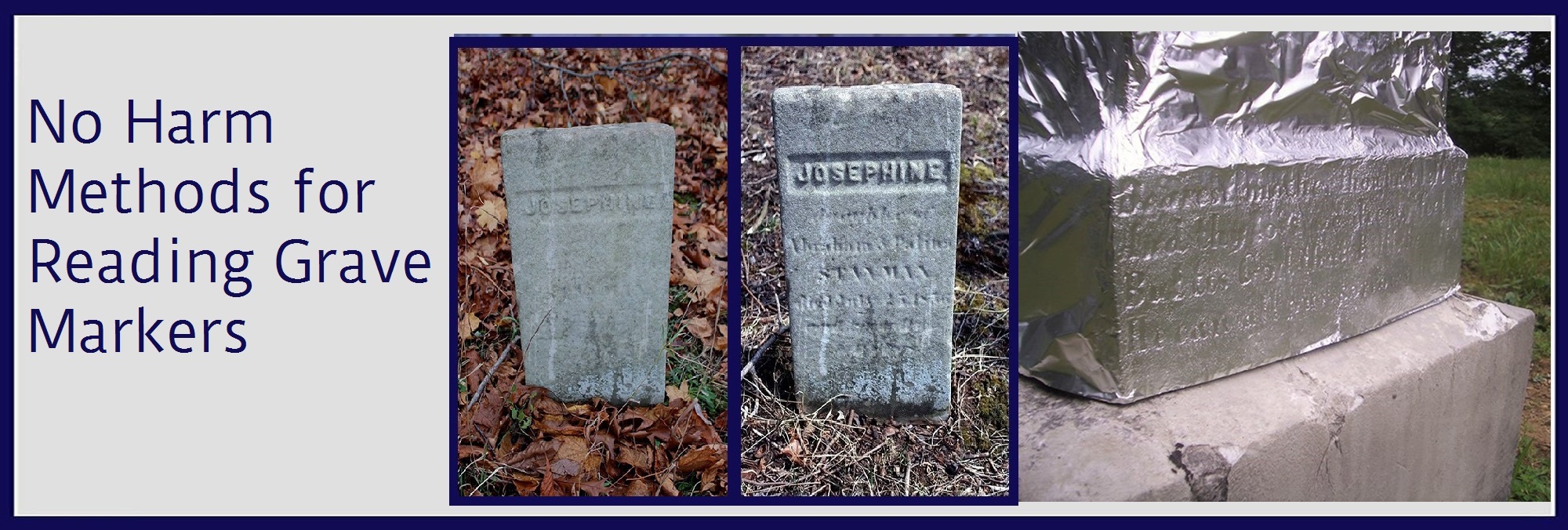
With the creation of things like find a grave and ancestry.com, the number of people interested in reading grave markers has grown significantly and continues to grow. It’s an old practice begun by family historians and genealogy groups to document the history of those who are no longer living. Being able to read tombstones and entire cemeteries, is a priceless piece of historical documentation. All too often this is accomplished by using some rather damaging techniques. This section will give you some of the best methods to collect the information you seek in a do no harm manner. These methods may take a little thought and time, but will not damage these priceless artifacts. Thus saving them for future generations to gaze upon. Please visit our section HARMFUL METHODS…Don’t read stones with, to better understand the damaging practices that harm grave markers. You may be unknowingly using one of those practices. And for your safety, please always make sure the tombstone or monument you are working with is sound and doesn’t present a danger of falling. And for the sake of the stone, please check for sugaring and delamination so you don’t inadvertently damage it further or permanently.
Doing it with Mirrors
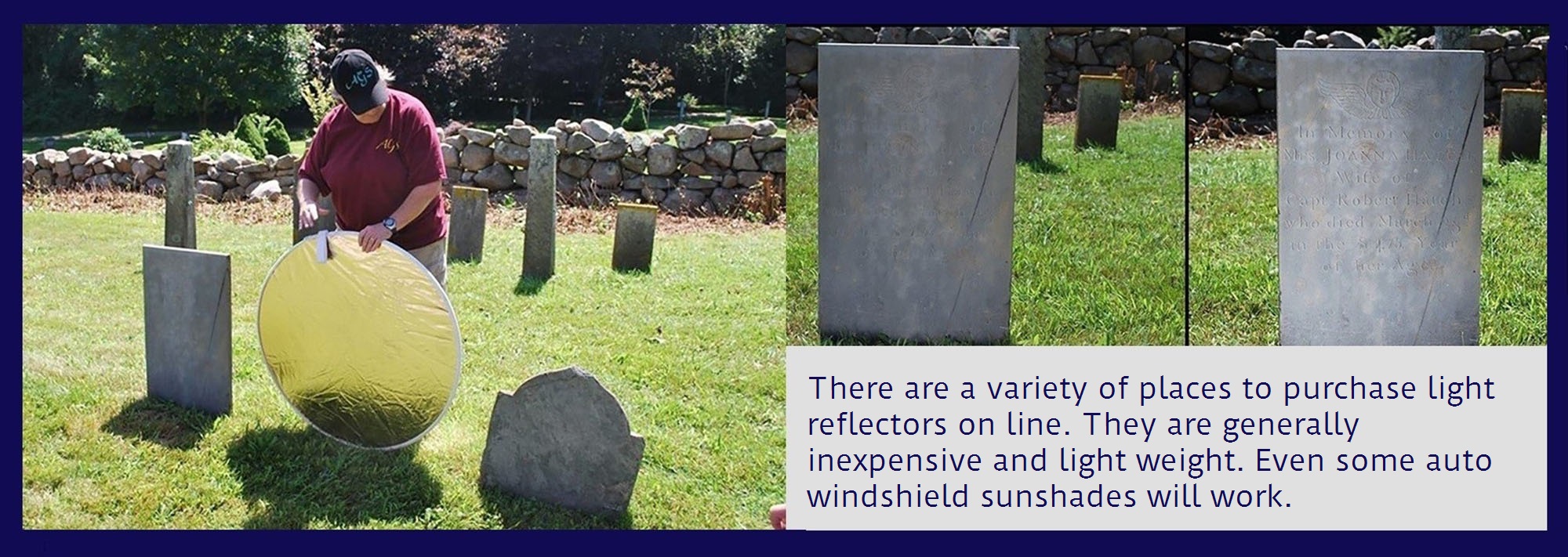
Doing it with Artificial Light
This technique works very well and doesn’t rely on sunny conditions, and often works better on cloudy days or in shady areas.
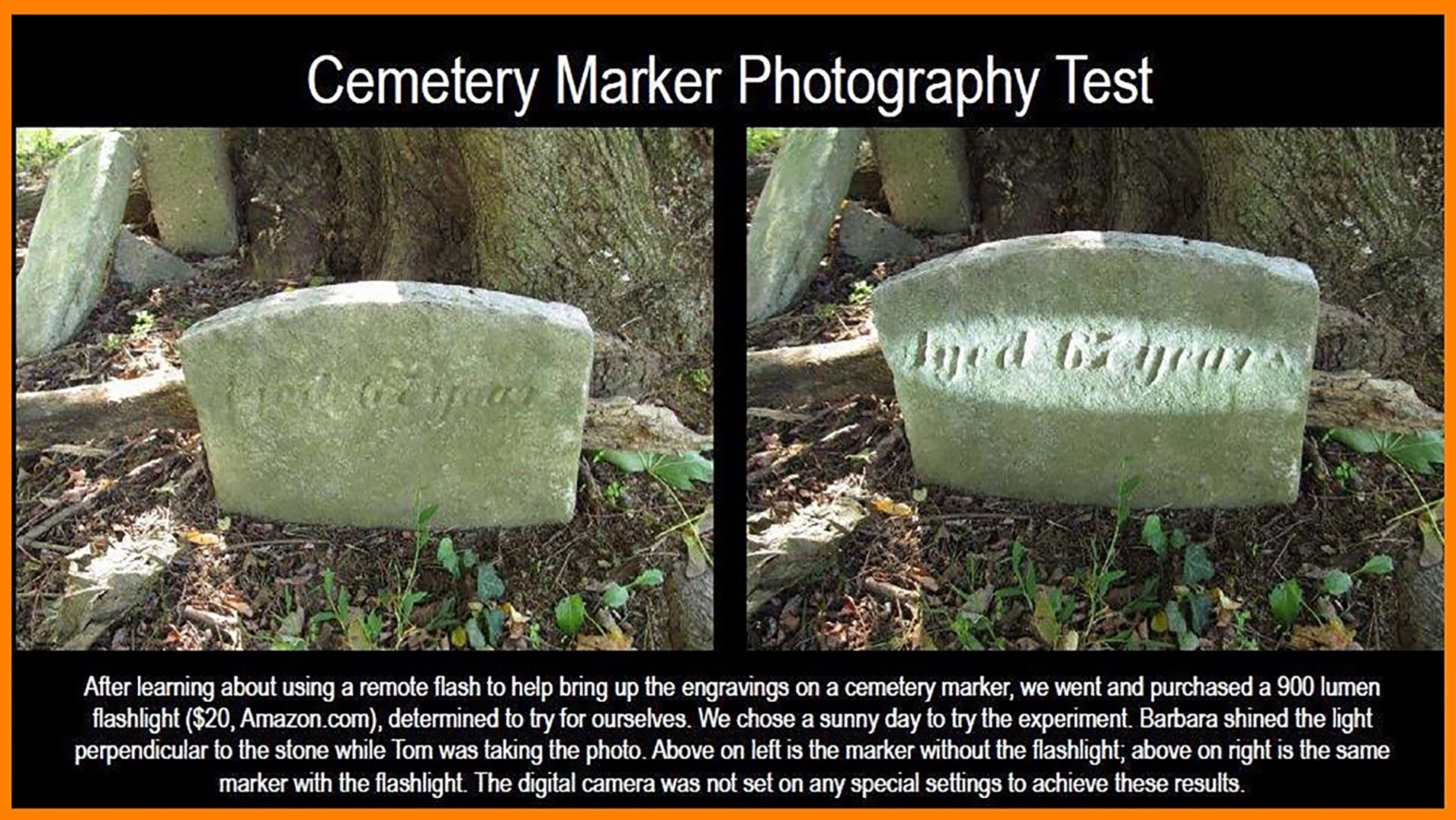
Doing It with Natural Light
Reading stones with natural light doesn’t require any special tools, just the right timing according to conditions.
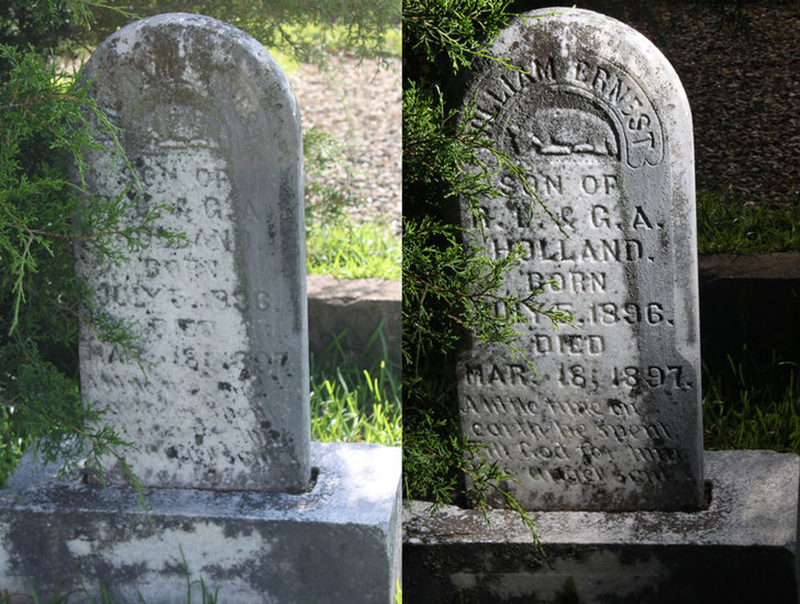
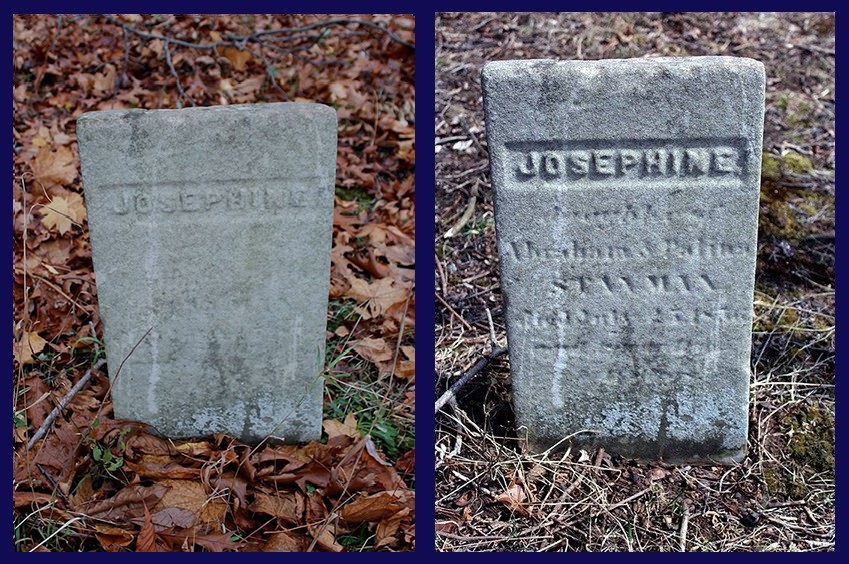
Doing It With Photo Programs
With today’s wide variety of digital cameras and different photo programs, there are many ways to adjust your pictures to make them legible.
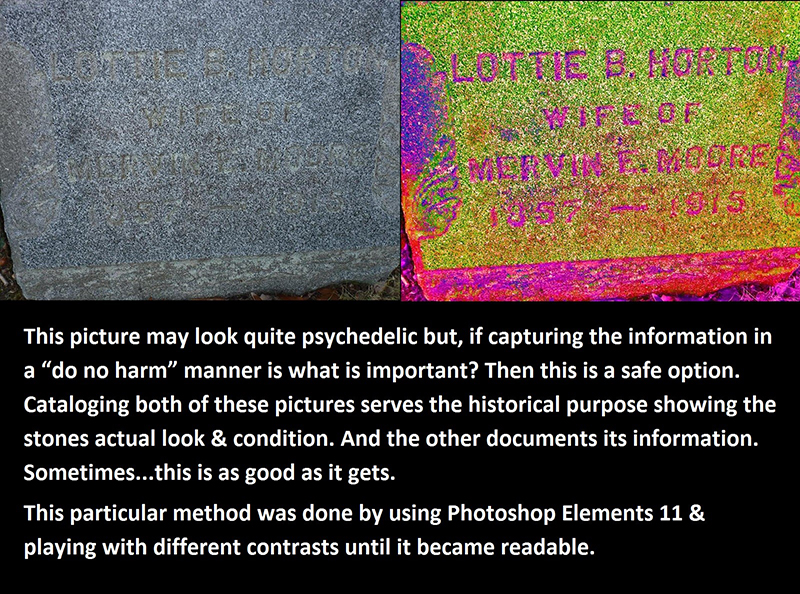
Doing It With A Foil Impression
Using foil to gently make an impression is becoming a popular method for reading stones. This method is harmless once you have determined there is no danger of the stone falling on someone. And after you have evaluated the stone to make sure it is not in a fragile state of extreme sugaring or delamination.

Doing It With Snow
Gently rubbing the stone with some snow and brushing off the excess allowing the snow to collect in the inscription, is another option. This method can produce some very good results. Again: After you have evaluated the stone to make sure it is not in a fragile state of extreme sugaring or delamination.

Gravestone Rubbings
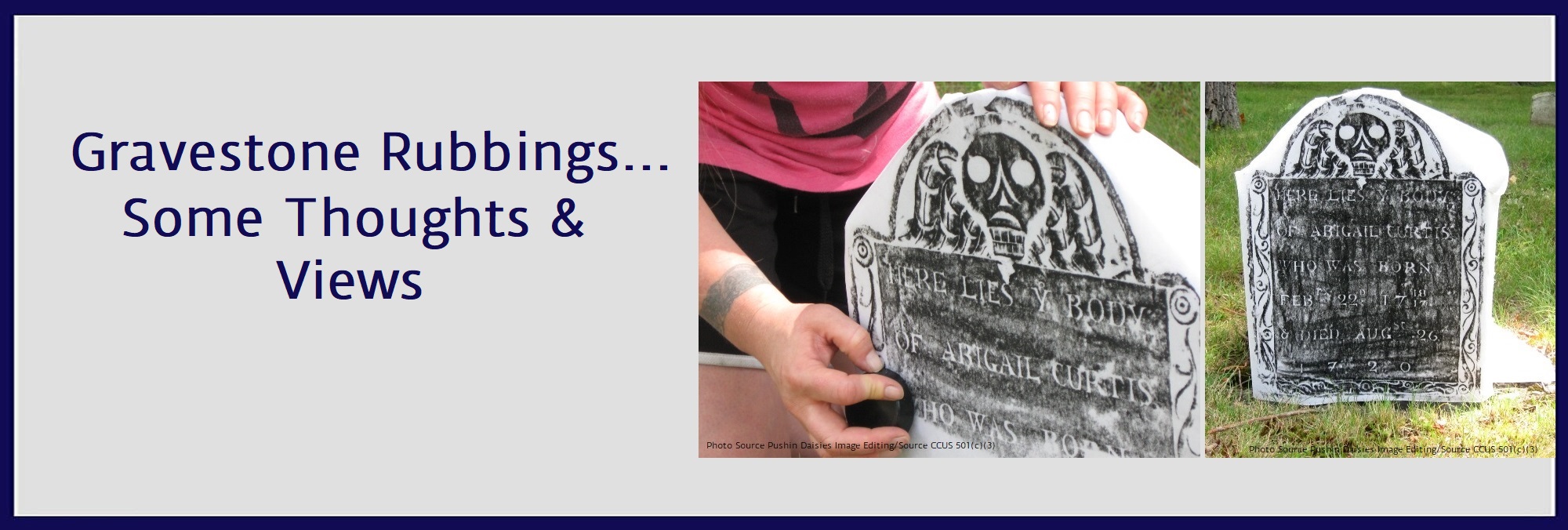
Gravestone Rubbings
By CCUS member Mark Morton in collaboration with other CCUS members
The Subject of Gravestone Rubbings has been hotly debated for almost as long as the technique has been around. And even mentioning this subject is bound to freak out several of the more well established organizations you may know of or belong to. So before we delve into this subject, let us begin with some very basic cautions at the outset
1…ALWAYS make sure any grave marker you are touching is safe from falling. See more on this caution by reading “Stone Tilt”. This can be found in any of the drop downs that link to “Safety”. You can also find this writing on PDF under ADDITIONAL INFORMATION in our PDF’s section.
2…ALWAYS make sure the stone you are touching is not chipping, peeling, sugaring, or falling apart to the touch. Causing this to happen by something you do is just further damaging the stone.
3…ALWAYS check to find out what you need to know about any necessary permissions you may need to obtain when doing anything to or with a grave marker. Caution: “some states and cemeteries expressly forbid rubbings to be done under penalty of arrest” This is quite often the case when it comes to the grave markers of the famous. Hundreds if not thousands of rubbings per season to individual grave markers causes extreme wear over time, and therefore this is why it may be prohibited.
Now that we’ve covered the cautions, let’s talk about rubbings after those cautionary steps have been met. Properly done rubbings on safe solid stones can be very safe without damage to the grave marker, if done with a little common sense. It seems most of the vitriol involved with those organizations that are vehemently opposed to rubbings stems from hyper over caution. Maybe it’s just a lack of explaining cautions concerning stone condition? Or maybe it’s an unwillingness to suggest anything that might violate some rule somewhere in some place? It mostly seems to be a mistrust that the person doing the rubbing will do damage using materials and techniques that should NEVER be used to begin with. Thus we are at the crossroads of common sense, and maybe that’s what they don’t wish to address.
We view it a little differently. Simply put, if a stone is solid enough to clean with water, a nylon brush, and a safe cleaner, “like the ones we have discussed under our cleaning section”, then you can certainly gently rub the stones face with paper and soft writing material. There is also no real difference in using this method or the foil rubbing method we have listed above. It’s also worth mentioning that some of the organizations against this practice will also advocate proper cleaning methods as we have just described. And some are now also conceding to the foil method. So what is the difference? It must boil down to the materials used when doing a rubbing. We have heard a few nightmare stories involving people using ink pens and magic markers and gouging through the paper, and therefore marking up the stone. If any of these organizations have real serious documented concerns that we have not addressed, please email us and submit these concerns.
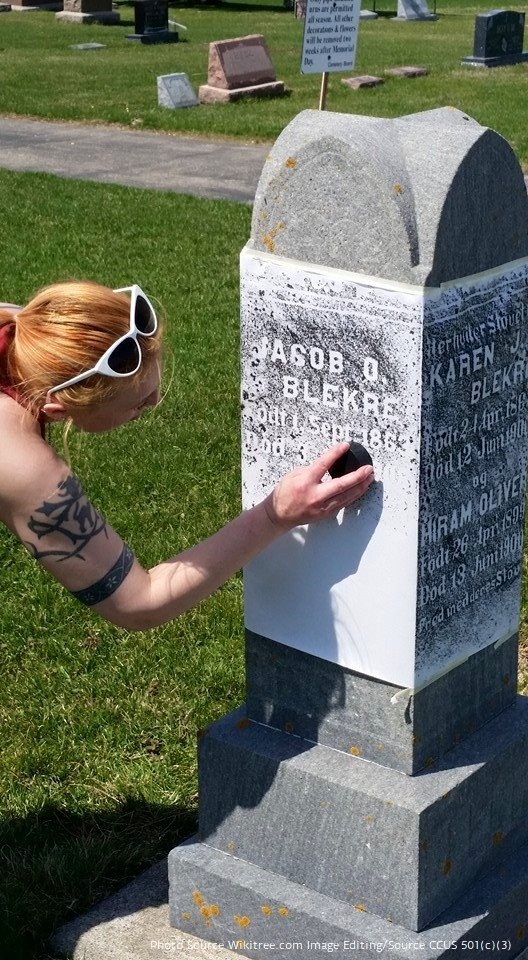
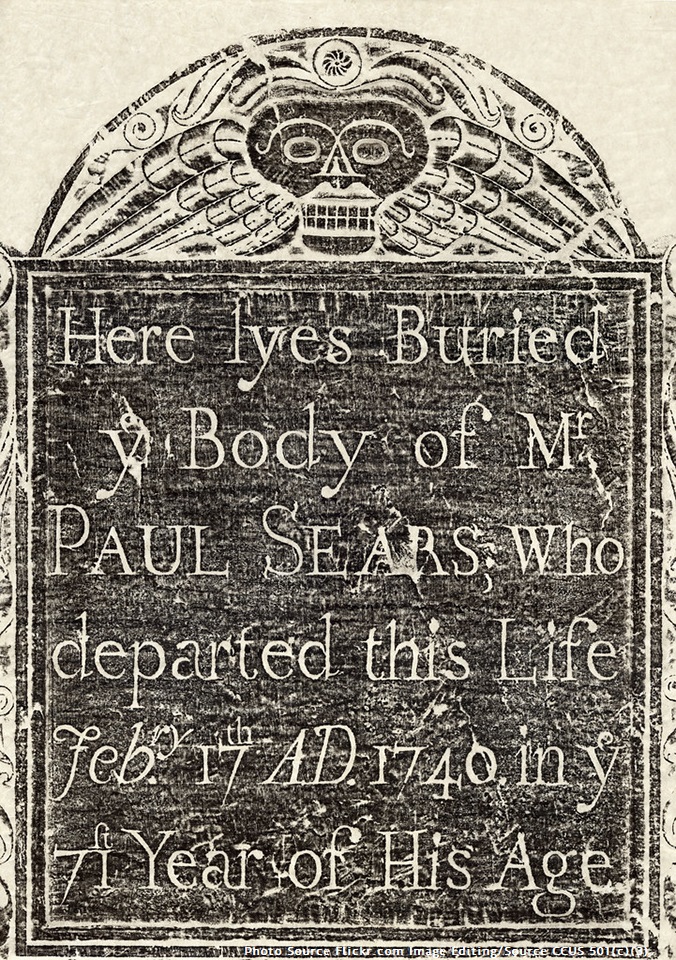
Gravestone rubbings can produce some beautiful artwork when done with some common sense, skill, and practice. Some do this for transcribing reasons and others do them for the personal reasons of having a personal life size copy. With so many modern techniques for transcribing, the need for rubbings to transcribe is not as necessary as in years past. So the choice is much more of an artful nature in this case.
Safe Methods For Rubbings When Done Properly
The following is one of the best and safest step by step descriptions we have found.

How to Do a Tombstone Rubbing
By Kimberly Powell…professional genealogist, author, and educator
August 6, 2018 on line source…ThoughtCo.
Tombstone rubbings are commonly used by family history researchers as a method for preserving a tombstone’s inscription. Learn how to do a grave rubbing safely, and when to use an alternative method of cemetery documentation.
How to Do a Tombstone Rubbing
1…Get permission. Check with the cemetery or with the state or local historical society to learn if tombstone rubbings are permissible. This practice has been banned in some areas and cemetery locations due to the damage it can cause.
2…Be sure that the tombstone that you have chosen is sturdy and stable. Do NOT do a tombstone rubbing on any stone that is wobbly, flaking, chipping, crumbling or otherwise unstable. Take a photograph instead.
3…If allowed, clean the tombstone with plain water and a soft bristle (natural or nylon) brush. Scrub the stone from the bottom up to avoid further streaking and staining. Flush well with water when you are done. Again, do not do this on a stone that is crumbling, chipping or flaking.
4…Cut a piece of plain white paper, butcher paper, rice paper or Pellon interfacing material to a size slightly larger than the tombstone. You can obtain rice paper from art supply stores and Pellon from craft and fabric shops.
5…Tape the paper or fabric to the gravestone. Make sure that it is secure so that it won’t slide as you are rubbing and cause a blurred image, and that it covers the face of the stone completely so that you won’t get marks on the tombstone when rubbing. If you have someone with you to assist, then you may prefer to have them hold the paper to avoid any possible damage from using tape.
6…Using rubbing wax, a large crayon, charcoal, or chalk, gently start to rub along the outside edges of your paper or material, carefully working your way in. Or you may choose to begin at the top and work your way down the tombstone.
7…Rub lightly to start with, and then apply more pressure to darken in the design if it suits you. Be very careful and gentle so as not to damage the tombstone.
8…If you used chalk for your grave rubbing, then carefully spray the paper with a chalk spray such as Krylon. Hairspray is another alternative. Be very careful not to get any on the tombstone.
9…When the rubbing is done, carefully remove it from the tombstone and trim the edges to suit your liking.
10…If you used interfacing for your tombstone rubbing, then place the material face up on an ironing board with an old towel over it. Press down with a hot iron (don’t use a back-and-forth motion) to permanently set the wax into the fabric.
Tips for a Better Tombstone Rubbing
Interfacing material is an especially good material for tombstone rubbings because it doesn’t tear and folds without creasing for easy travel.
Caught without supplies? In a pinch, you can use green leaves to do the rubbing as long as you can put your hands on some paper.
Consider other methods of preserving the tombstone inscription such as photographs or foil casts as an alternative to the potentially damaging tombstone rubbing.
Practice makes perfect! Before going to the cemetery, contact a local monuments store to see if you can practice rubbings on one of their tombstones.
Check local laws before visiting the cemetery. Some countries don’t even allow tombstones to be photographed without the permission of the cemetery keeper.
Be sure to pick up any trash and leave the cemetery just as you found it.
Following the common sense steps and guidelines above will ensure your rubbing does not do damage.
We thought we would also attempt to clarify a couple of things on this subject that several of our conservators believe are worth mentioning. Rubbings of this nature are not to be confused with applying chalk or flour to a stone in order to read it. Those are DAMAGING methods that will be discussed directly below. The article discusses cleaning the stone first. This will be your choice and determination as to if the stone is too heavily covered in lichens to obtain an accurate rubbing. If you need to clean the stone please refer to our CLEANING section in the menu and allow the stone plenty of time to dry before you apply the paper. Oversized paper that wraps around the stone seems to work best. This makes an almost paper sleeve for the stone that won’t move as easily in the wind and allows you to apply your tape from paper edge to paper edge. And speaking of tape, always use the blue or green painter’s masking tape, NEVER use duct tape.
We will be adding to this subject as more techniques are reviewed and vetted.
January 19, 2020 – CEMETERY CONSERVATORS FOR UNITED STANDARDS
Don't Read Stones With
Now that we have walked you through the “do no harm” methods for reading stones, we will explain the harmful methods some have used in their stead.
The list of harmful products and methods used to read tombstones and monuments is simply huge. Over the last 50 or so years, many things have been applied to stones to achieve this. Sadly, many have become ingrained lore with organizations and individuals. Thus perpetuating damage because someone else was doing it this way long before someone new came along. Repeatedly doing the wrong thing never makes it right at the end of the day. This section is designed to explain why these methods are harmful. We encourage you to please visit our section under BASIC STANDARDS…Reading Stones, to find our list of least invasive do no harm stone reading methods. And we hope you will pass it on to the individuals and organizations you know or are part of, before the next cemetery reading adventure takes place. Together we can continue to document these historic places without inflicting damage.

Shaving Cream
Shaving cream shares the number one spot for most widely used damaging method for reading stones. It’s much safer on your face than on a porous stone. This in part goes back to ph. balance and the stone acting as a sponge. The following gives exacting reasons on why this is harmful.
By Mary Striegel of the NCPTT May, 2012
There are many sources that discourage the use of shaving cream on gravestones. Shaving cream includes Water, Stearic Acid, Isobutane, Laureth-23, Fragrance, Propane, Sodium Lauryl Sulfate and other compounds intended to make your face feel smooth. Grave markers can be made from many types of stone. Marble, limestone, and sandstone are sensitive to acidic compounds, depending on the particular rock and mineral formation. Shaving cream has a pH of around 5, similar to acid rain. Other compounds in shaving cream do promote biological growth, depending on where the grave stone is located. Emollients are not as water soluble as other compounds, and weathered stones are often more porous than new stones. Dirt can be more attracted the ingredients in shaving cream, even on well-rinsed surfaces.
In short, by applying shaving cream you are dowsing the stone with acid rain and attracting biological growth that will make the stone more unreadable. Biological growth also brakes down the molecular integrity of the stone.
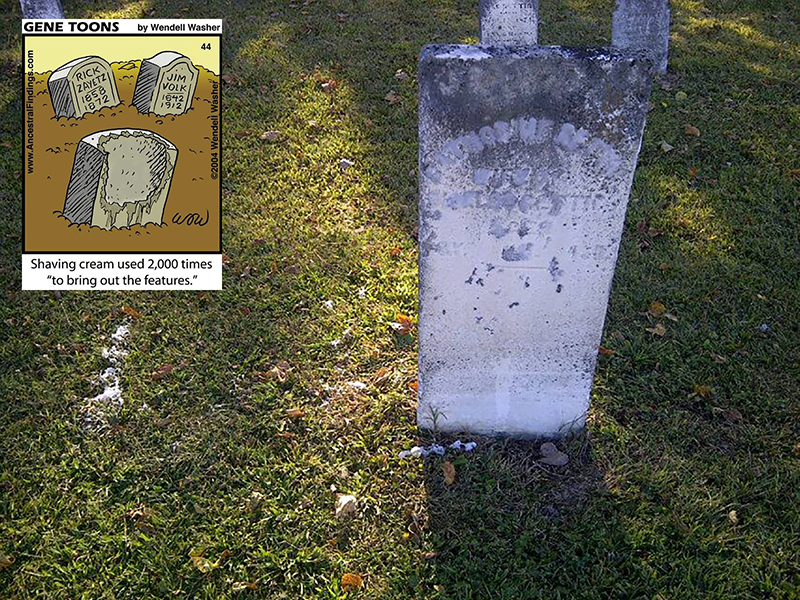
Chalk
Chalk is the other that shares the number one spot with shaving cream for harmful ways to read grave markers. Old marbles, sandstones, siltstones, and the like are very porous stones. If you chalk a tombstone, you are entering the following substances into the pores of the stone. Plaster of paris, silica, alumina, iron, phosphorus, and sulfur. In less significant amounts, manganese, copper, titanium, sodium oxide, potassium oxide, fluorine, arsenic, and strontium. Yes…I said arsenic. Today’s children’s sidewalk chalk is made from quite a chemical soup of things. This list also includes sodium oxide. Sodium anything is harmful to porous stones. In addition to these harmful chemicals, chalk may permanently stain the stones. Especially if it is colored chalk.
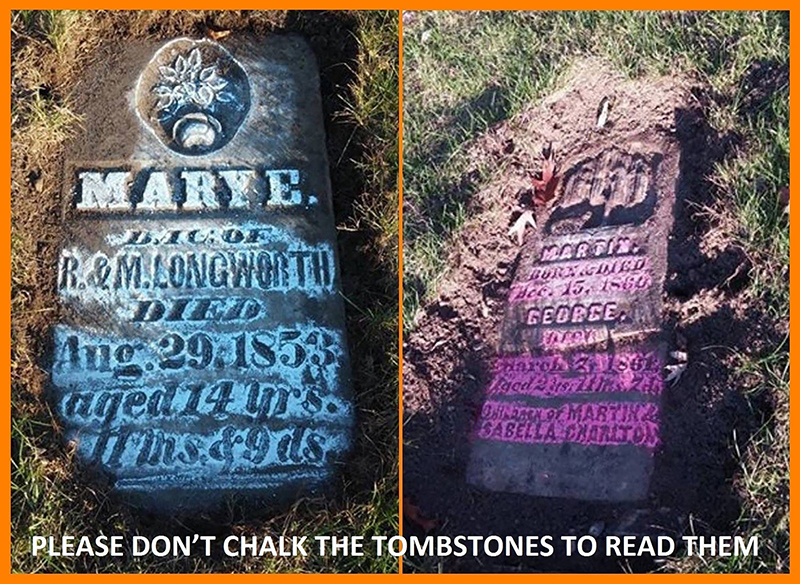
Paints and Markers
Permanent harmful methods with an immediate result include, paints and ink markers. Methods such as these simply permanently deface a grave marker and may be viewed in many communities by law enforcement as vandalism. Pens and markers permanently stain the stones, and paint does the same thing. Paint also effects the stone by acting as a sealant and in turn not letting its sponge like quality take moisture in and out. Simply, the stone quits breathing and may trap water inside that will cause it to break in a freeze, or rot from being water logged. And once again, you are introducing a plethora of chemicals into an old porous stone.
Please don’t paint old tombstones unless they were intended that way. And even then, consult a cemetery preservationist or monument company expert. Cemeteries spend thousands of dollars each year to remove paint.
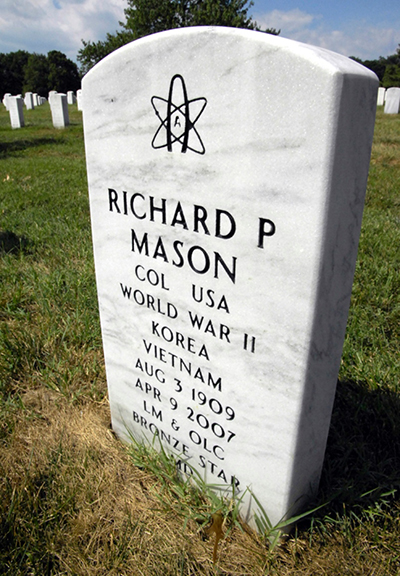
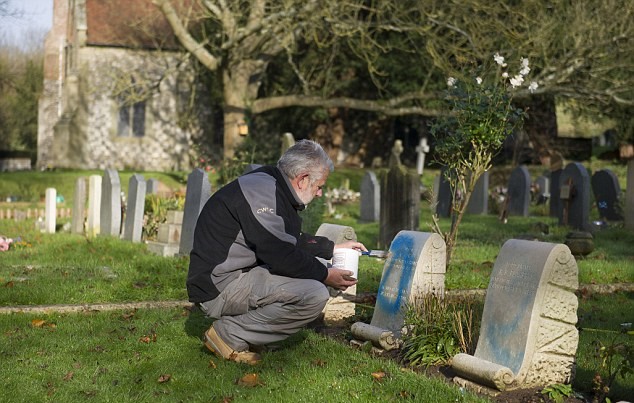
Household Cleaners
Household cleaners that can be harmful if used to read grave markers include, soaps, cleansers, bleaches, ammonia, detergents, and peroxide. These products are harmful as well due to the nature of their chemical makeup. Almost all modern soaps and cleaners are made the following way.
Soap is a mixture of sodium salts of various naturally occurring fatty acids. Air bubbles added to a molten soap will decrease the density of the soap and thus it will float on water. If the fatty acid salt has potassium rather than sodium, a softer lather is the result.
Soap is produced by a saponification or basic hydrolysis reaction of a fat or oil. Currently, sodium carbonate or sodium hydroxide is used to neutralize the fatty acid and convert it to the salt.
General overall hydrolysis reaction:
fat + NaOH —> glycerol + sodium salt of fatty acid
Although the reaction is shown as a one-step reaction, it is in fact two steps. The net effect as that the ester bonds are broken. The glycerol turns back into an alcohol (addition of the green H’s). The fatty acid portion is turned into a salt because of the presence of a basic solution of the NaOH. In the carboxyl group, one oxygen (red) now has a negative charge that attracts the positive sodium ion.
Again the problem with most cleaners not being appropriate for stones is their sodium content.
Household Baking Items
Dry powdery household products that are not recommended for reading tombstones include, flour, cocoa, cornmeal, powdered sugar, baking soda, and baking powder. Typical baking ingredients from the kitchen should stay in the kitchen and be used in meal preparation. These items are by far the least harmful in comparison to those above. But because these products are of a perishable nature and are used in food preparation, they will rot, mold, and form yeasts. Covering a tombstone in these items is like creating a giant petri dish. The left over powders will work into the porous parts of the stone and engravings forming biological growths.
Further Information on this Subject from other Sources
Courtesy of CCUS member Cynthia Nicols cemetery preservationist from Indiana
A source from headboards of stone blog August 2010
A NOTE ABOUT SHAVING CREAM, FLOUR etc.
A word of advice, DON’T use shaving cream, flour or anything else on tombstones!. These have many ingredients harmful to tombstones (like butane) and in some cases can be abrasive. There are a number of websites that promote this method, with one going so far as to assure that the shaving cream will not harm the stone. Please do not attempt this as you WILL be causing a great amount of damage to the stone and even by washing it after you are finished you will not remove all of the material that you have placed on the stone.
Read More
Other areas of interest that pertain to reading stones
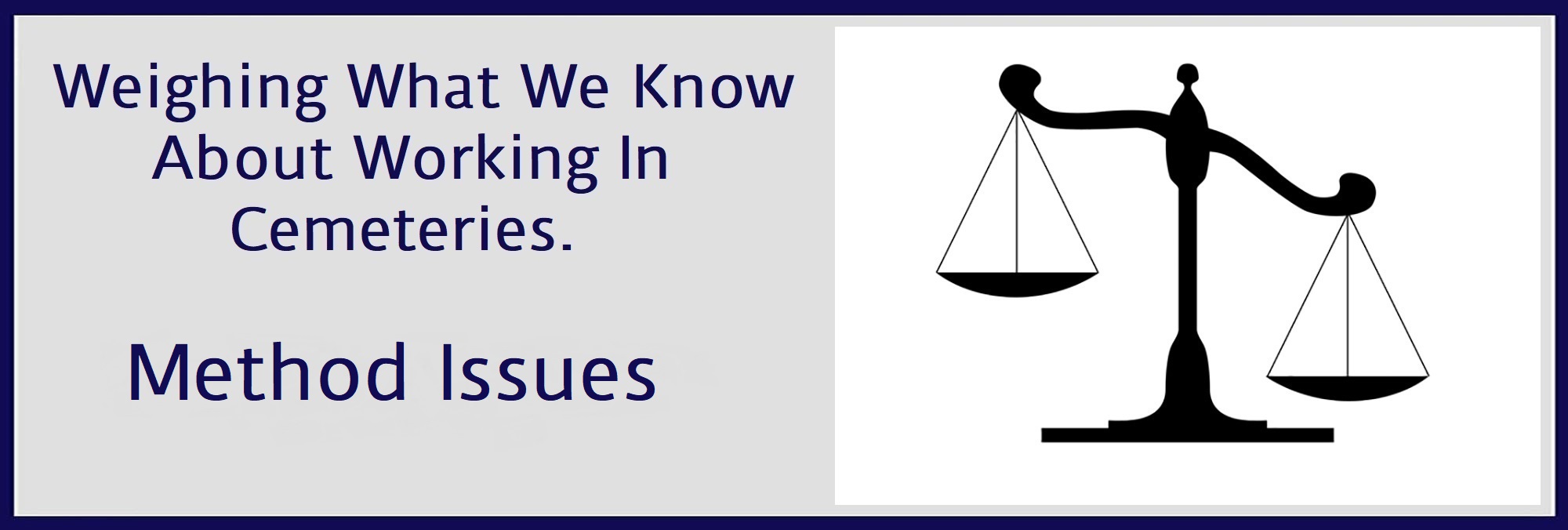
For more discussions that may have a bearing on tablet setting methods, mouse over PRO VS CON and choose The Field In General and Method Issues. You may also find the other categories under PRO VS CON helpful as well.
This section is here to weigh out the many “Pros VS Cons” that seem to exist in this relatively young field known as the cemetery preservation and restoration. A young field born out of the need and want to maintain the memorials left us in cemeteries. Maintaining things from the past has been around almost as long as the past itself. Art, documents, books, buildings, and now cemeteries. After the desire to save these things is met, then begins the how to save them, through what means and with which forms of maintenance. This quickly becomes a much clouded issue for many. We hope to lift this fog with some simple fact based thoughts and principals. Our cornerstone or main pillar for doing this will be a thing called, “Do No Harm”.
This section has two main goals. One is to lay out and examine the field itself and all of its controversial issues, problems, and divisions. The second main goal of this section is to lay out the said issues involving methods, techniques, and products, and run them through the list of 6 or more questions below. This is where you find the meat of the discussion before it is weighed out with these questions.
We are addressing as many of these issues as we can at this time with the following subcategories in this section. “The Field In General” subcategory addresses the overall methodology of the field itself. Other subcategories such as Cleaning and Bonding Agents, and others to be added, will address more specific methods and products.
These are the 6 standard questions we will ask of all methods, techniques, and products suggested or discussed on The Cemetery Conservators For United Standards website. Additional questions may be asked pertaining to a given subject depending on the need to ask them based on the subject. You will find the completed version per product and/or method under SOURCES…Pro VS Con Results.
1…MSDS… based on the MSDS recommendations. (Scale of 1 to 10) 1 being the most invasive or highest risk to a person’s health & safety. And 10 being the least invasive or lowest risk to a person’s health & safety.
2…Testing…has it been tested? (Scale of 1 to 10) 1 being the lowest # of testing done. And 10 being highest # of testing performed.
3…Longevity & Performance… based on reliable reports concerning how long & well the product holds up. (Scale of 1 to 10) 1 being the shortest longevity & lowest performance. And 10 being the most longevity & best performance.
4…Track Record & Wide Spread Use…How well has this substance or product in this technique held up over the years & how many places has it been used? (Scale of 1 to 10) 1 being the worst track record, least widely used, & least places used. And 10 being best track record, most wide spread use, & most places used.
5…Permanence…is the substance or product in this technique, reversible or nonreversible? (Scale of 1 to 10) 1 being the lowest possibility of reversal. And10 being the highest possibility of reversal.
6…Cost & Training…how expensive is the product & is there specified training required & what is its cost? (Scale of 1 to 10) 1 being highest cost & most training. And 10 being lowest cost & least training.
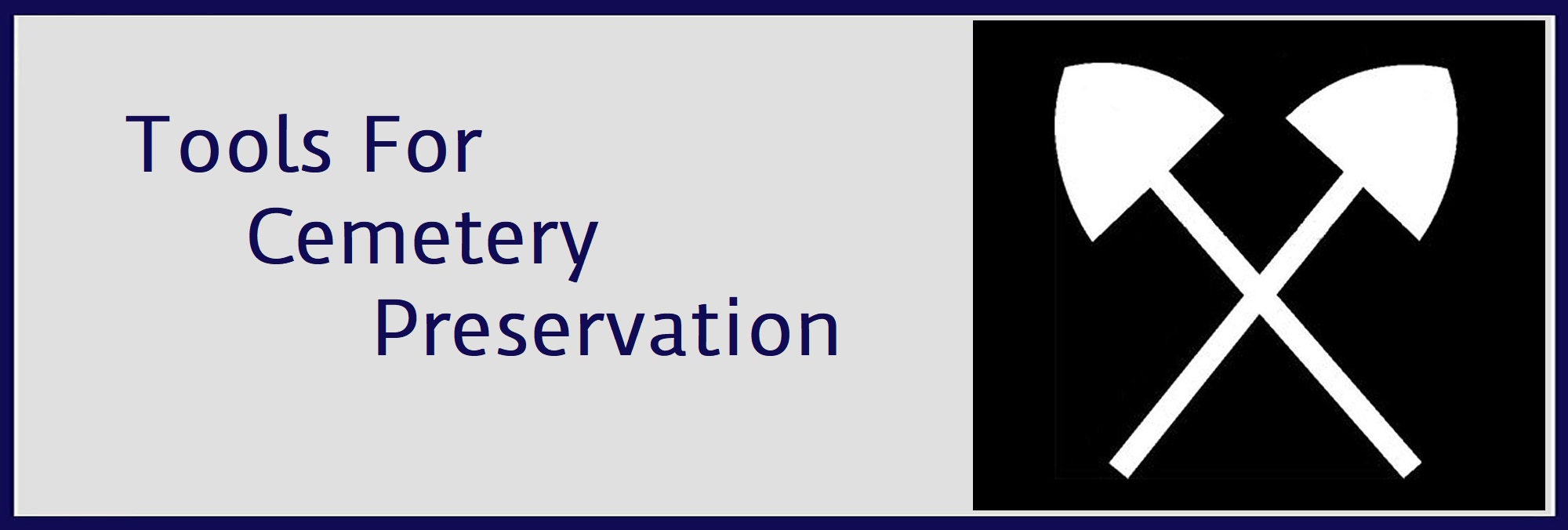
TOOLS & SUPPLIES…things we suggest to better aid in your cemetery preservation work can be found here.

TECHNICAL…is the place where we house all information for products used and has Product Explanations, Product Information Sheets, and MSDS

SAFETY…is always an important place you should visit at every step along the way
SAFETY – a place for all safety related issues found in cemeteries and in the preservation of cemeteries. Every year people are killed due to unstable stonework in our cemeteries. Over time many of these monuments begin to lean and teeter. And unsuspecting visitors are crushed because they disturbed one of these loose monuments. We wish to remind people of this situation and caution them from such tragedies. Safety is also equally important for those who choose to do some sort of restoration work. The hazards can range from a pinched finger to being killed by a large stone. I can say all of our members take safety very seriously and make it our constant number one priority in everything we do. We please ask that you do the same. This section will try to address this issue as much as possible. Let’s all be safe out there in all that we do.

This is where you will find the latest video links to cemetery preservation and restoration. There are many great videos from both professional organization and CCUS members. We will constantly add new media as it becomes available. Mouse over VIDEO and choose an area of interest. You will find one of the six areas below to view.
Cleaning – the best ways to clean with no harm.
Hoist Work – lifting stones with a hoist type system.
Repair Work – putting the broken pieces back together again.
General Field Work – a collection of misc. preservation work.
Good Preservation – what good preservation looks like.
Bad Preservation – what bad preservation looks like.
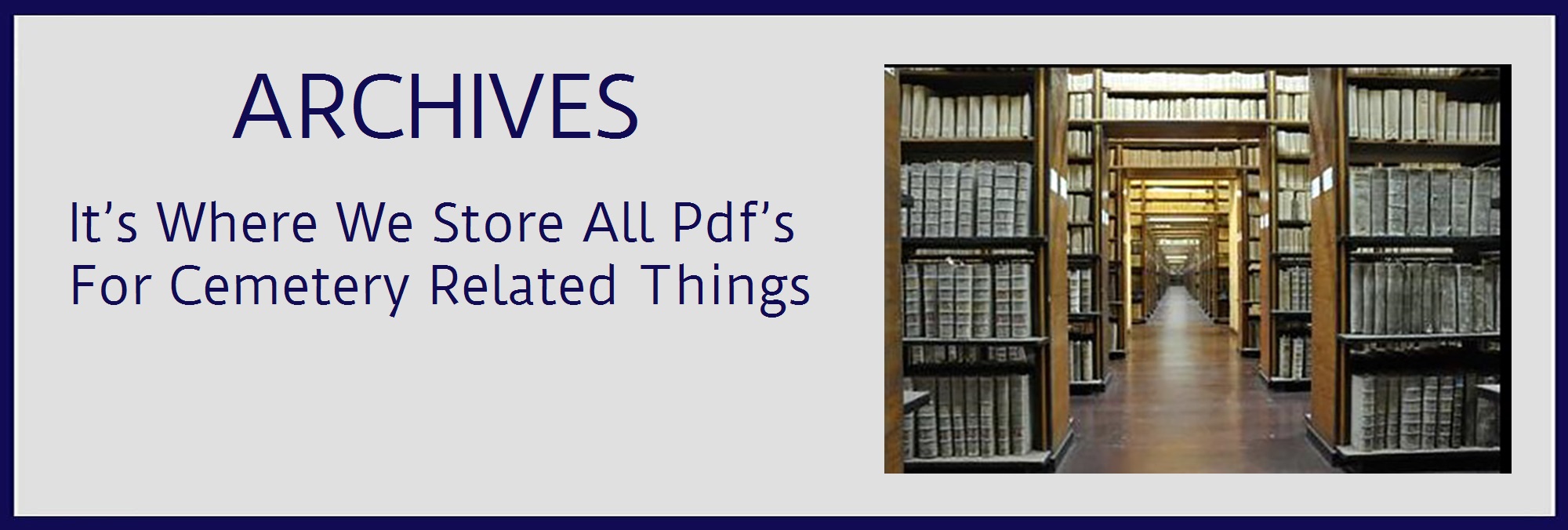
ARCHIVES…is where we house downloadable pdf’s and FREE cemetery preservation related images for you to use. We have jam packed this ever expanding library with pdf’s on important cemetery related issues. We wanted you to have a place where you could easily view, print, or download important information. We encourage you to share it with other individuals or groups you may know that are interested. There is no such thing as too much cemetery awareness.